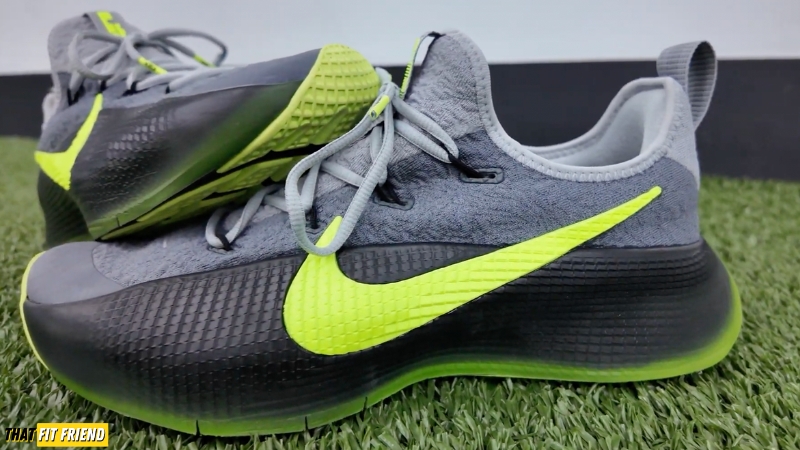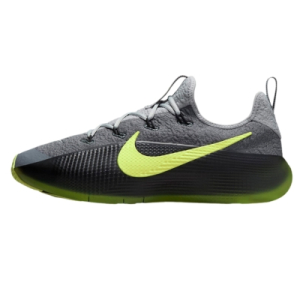That Fit Friend is supported by its readers. I [Jake Boly] run this site myself and buy the gear I review. If you purchase through my site, I may earn commissions on sales, read more here!
The Nike LeBron TR 1 has been one of the most interesting training shoes I’ve reviewed in 2024.
Let’s cut to the chase; I think because this shoe was made in collaboration with King James himself, it’s received a lot more attention than your traditional Nike trainers. This shoe has received more buzz than other Nike shoes like, the Metcon 9, for example.
My experience with the LeBron TR 1 has been one of many twists and turns. When I first put these shoes on, I actually didn’t like them that much, and I had a tough time trying to figure out where the heck they fit in on the spectrum of training shoes.
However, after multiple sessions, I think I’ve narrowed down where this shoe excels the most and in what contexts it works best. It’s NOT going to be a training shoe for everyone — and if you need a model for lifting or HIIT, check out my cross-training shoe guide.
Training Stats In This Shoe
| Lifting Sessions Logged: 15 | Cross-Training Sessions Logged: 14 | Total Miles Logged (Walking and Running): 15 |
| Max Deadlift Performed In These: 385 lbs | Fave Exercises In These: Jump rope/box jumps | Running: Broken up into 400-1,200 meter intervals |
| Max Barbell Lunge Performed In These: 205 | Least Favorite In These: Skater strides (width issues) | Walking: 2-3 mile dog walks & full days of errands |
| Max Power Clean In These: 235 | Are They Good for Classes: Average |
Who Should Buy This Shoe?
- You’re An Athlete Wanting a Trainer: I have to give credit where credit’s due. The LeBron TR 1 can be a good option for the athlete who needs that all-in-one style training shoe for some lifting, jumping, and explosive work in the gym.
- Narrower and Medium Feet: I find these to run narrow. I have E/EE-width feet, but I need narrow and medium-width feet. You’ll likely feel right at home in this model. My YouTube community jokes that they must have modeled these after James’ feet (I know you’ve seen those photos!).
- You Love Classic Nike Trainers: I think one thing I came to appreciate with the LeBron TR 1 is that it has that classic “athletic” fit that older Nike shoes had. Think circa 2010-2020. If you’re a fan of that fit style, then you’ll enjoy these.
Who Shouldn’t Buy This Shoe?
- Wide Feet: To no surprise, wide and flat feet should pass on this shoe. I think you can get away with these if you have EE-width feet and wear thin socks, but you’ll likely find them to fit a little snug still. These also have a bit of arch, so flat feet, be warned.
- For a Wider Trainer: Born Primitive Savage 1 or Adidas Dropset 3
- You Need a Trainer for Heavy Lifts: This model can work for some general strength stuff, but I’d pass on them for heavy stuff. For example, I’ve hit some deadlifts up to 385 lbs in them, and north of 365 lbs, that’s when you start to notice some compression.
- You Like a Flatter Trainer: These shoes have a bit of a heel to them so if you’re big on not feeling pitched forward, then you’ll want to look into trainers that have a lower heel-to-toe drop. The Nano Gym has a similar pitched forward feeling if you’ve ever worn those.
- Flatter Trainer to Explore: UA TriBase Reign 6
Specs to Know
- Heel-to-toe-drop: NA (classic Nike not providing this, feels like 5mm+ to me)
- Stack Height: NA
- Removable Insole: Thin Foam
- Weight: Size 10 Shoe 12.40 oz (0.348 kg)
| LeBron TR 1 Pros | LeBron TR 1 Cons |
| Good for Plyos | Not great for Heavy Lifting |
| Nice Lateral Security | Fairly Aggressive Toe Spring/Heel Bevel |
| Moderate Arch Support | Not Idea for Wide Feet |
| Form-Fitting Upper |
Sizing Tips, My Suggestions
For the vast majority of lifters and athletes, true to size should be the safe call in the LeBron TR 1.
If you already wear Nike models like the Free Metcon, MC Trainer, or Air Zoom TR 1, go with the same size in the LeBron as you did in those models. For those coming from companies like Adidas and Reebok, I’d also go with the same size in this shoe.
- If you have narrow, medium, and slightly wider (E…maybe EE) feet, then you should be okay with these.
- For feet wider than EE-widths, I’d pass on this shoe entirely.
- This model has a noticeable arch. If you have flat feet or can’t stand having arch support in your shoes, swerve these as well.
What My Community Is Saying
These shoes have received a ton of comments on my YouTube channel from both buyers and prospective buyers. The general feedback has been mixed with a lot of strong opinions. Folks either LOVE these or DESPISE them.
“Put these through 3 bootcamp style workouts and while they did get more comfortable over time my biggest issue was the upper volume. I generally like booty-style training shoes, but due to the upper material, which doesn’t stretch much, i found them really rubbing the tops of my feet. I hope they continue the line and make improvements, but these were a no-go for me.”
“Idk what these ppl talking bout these are fire! And it’s a LeBron shoe!! How do you hate on a big swoosh?? Lmaooo the bigger the better it looks amazing!! Missed out on it might pay resell!!”
Performance Assessment
Because this is a LeBron training shoe, I tried to bias my tests towards what most who will be buying these shoes will likely be doing. This includes workout sessions with a lot of lifting and explosive movements and some HIIT sprinkled in.
Average Lifting Performance, As Expected
- Look, I didn’t expect the LeBron TR 1 to be a killer for lifting, but it’s also not terrible for general lifting. It reminds me of models like the MC Trainer, as it gets the job done, but it’s not as dialed as a Metcon 9.
- Midsole compression-wise, I didn’t notice too much compression until I pushed past 365 lbs on deadlifts. If you’re keeping your barbell lifts below that weight, then you should be more than fine in these.
- There is a bit of a drop in this shoe, so I’d also say expect a “pitched forward” feeling in these when lifting. If you’re big on lifting barefoot or training with lower drops, then I could see this bothering you.
- For machines, this shoe does a solid job. The outsole has enough grip to prevent slipping, and the midsole is dense enough to load up leg presses and hack squats.
- Summary: If you’re hitting general strength workouts and not after a trainer for maxing out barbell lifts, then you’ll be fine in these. They did better than I expected for my tests, which was a nice surprise.
Like the socks featured in the photos in this review? Shop the TF2 Legacy Crew Workout socks! It’s an easy way to support the brand, and these socks have already received killer feedback from the community!
Decent for Cross-Training and HIIT
- While I find the upper to be a little snug at the forefoot, I do see its benefit for lateral security. The TPU/rubbery overlay on the lateral forefoot adds a nice base to drive into when doing lateral explosive work.
- The foam midsole has a nice bounce to it, and if you’re regularly doing jump rope, box jumps, and things like high knees/hurdles, then you’ll enjoy the feedback and responsiveness that you get with this shoe.
- The outsole is covered with a rubber with a herringbone tread pattern, and on most surfaces, it did a really good job. I will say keep an eye on the forefoot if you plan to do heavy sled work. We saw how the Free Metcon 6 split with this type of work, and the LeBron TR 1 has a somewhat similar construction. Pushing four plates, I haven’t had any issues yet, fortunately.
- My main gripe with this shoe for cross-training is that it can feel wicked snug, and the upper doesn’t break in a ton due to the thicker lateral materials. If you have a thick foot or like shoes that eventually get a little give to them, then you’ll likely find this offputting.
- Summary: All-in-all, these have been a decent “athlete’s shoe” for cross-training. If you’re an athlete who needs a shoe for gym sessions that have conditioning and explosive elements, then you’ll like these.
Can Work for Running, But They’re So-So for All-Day Wear
- For running, I’ve primarily used this shoe for intervals on the treadmill and curved treadmill. I assume that’s how most will also be using these for their running needs, AKA in a class-like conditioning style of running.
- If you’re tackling distances between 400-1,200 meters, then you should be okay with these, especially if you’re a forefoot striker. At these distances with a faster pace, I actually didn’t mind these shoes or find them to be super uncomfortable.
- For runs longer than a mile, I’d pass on this shoe and find something that’s a bit more “hybrid-friendly” with its construction, like the Inov8 F Fly, or opt for a running shoe to double down on maximizing your performance and comfort.
- For daily wear and walking, I don’t love these shoes. That’s due to their lower-volume upper and snugger toe box. They can work for errands and walks, but for true all-day wear, I think most will find them a little too snug.
- Summary: For running distances that most will be doing in conditioning sessions, these can work. Bonus points if you’re a forefoot and midfoot striker. For all-day wear, these are “meh”, and there are more comfortable models out there for this ask.
Final Remarks, Would I Buy These Again?
Probably not, but that’s not because they’re a “bad” shoe.
When building this review, I kept in mind that I’m just not the Nike LeBron TR 1’s primary demographic. With that in mind, I tried to keep a more objective point of view for this model.
I think they can be good shoes if you’re an athlete who has the foot anatomy that aligns with this model. For everyone else, or anyone who wants a trainer for more lifting and CrossFit, these will be a total miss.
For a first pass, these aren’t bad, Nike. Do I think there are things that could be improved, like the toe box and upper volume? Yes, however, these are pretty well-rounded in the gym for what they are, and if you’re vibing with them, then I’d proceed with confidence.
If you have additional questions about these shoes, drop a comment below or hit me via Instagram, and I’ll answer what you got!

















Add a Comment